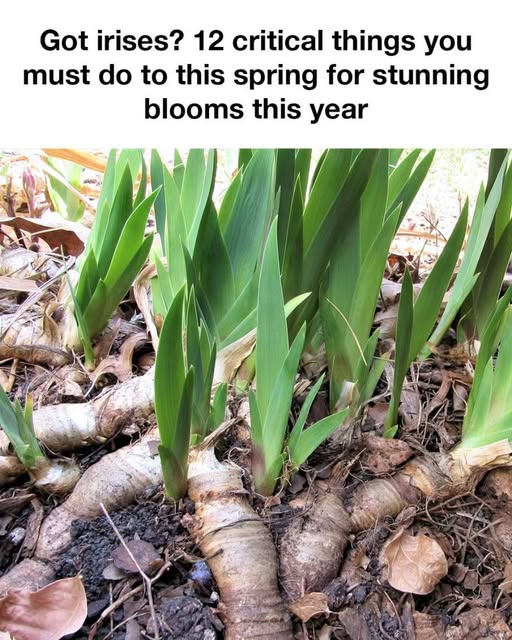ADVERTISEMENT

I didn’t know about this
Preparing Your Garden for Irises: Essential Steps
Before focusing on individual plants, it’s important to prepare the entire garden area where your irises will grow. This involves clearing away debris, ensuring the soil is in good condition, and planning for any necessary changes to the garden layout. By creating an optimal environment, you give your irises the best chance to flourish. This preparation also includes checking for any potential pest issues and ensuring that the garden receives adequate sunlight and water.
1. Assessing Soil Conditions for Optimal Iris Growth
Irises thrive in well-drained, fertile soil. Begin by testing your soil’s pH level, which should ideally be between 6.0 and 7.0. If your soil is too acidic or alkaline, consider amending it with lime or sulfur to adjust the pH. Additionally, enrich the soil with organic matter, such as compost or well-rotted manure, to improve its fertility and structure. Good soil conditions are essential for healthy root development and vibrant blooms.
2. Ensuring Proper Drainage to Prevent Root Rot
Irises are susceptible to root rot if they sit in waterlogged soil. To ensure proper drainage, consider planting irises in raised beds or on slopes. If your garden has heavy clay soil, amend it with sand or gravel to improve drainage. Avoid planting irises in low-lying areas where water tends to accumulate. Proper drainage is crucial to prevent root rot and promote healthy growth.
3. Pruning and Cleaning Up Last Year’s Foliage
In early spring, remove any dead or damaged leaves from your irises to encourage new growth. Cut back the foliage to about 6 inches above the rhizome, being careful not to damage the plant’s base. This cleanup helps prevent diseases and pests from overwintering in the old foliage and allows sunlight to reach the new shoots.
4. Dividing Overcrowded Clumps for Healthier Blooms
Irises can become overcrowded over time, leading to reduced blooming. Every three to five years, divide the clumps to ensure each plant has enough space to grow. Dig up the rhizomes and separate them, discarding any that are diseased or damaged. Replant the healthy rhizomes with adequate spacing to promote air circulation and prevent competition for nutrients.
5. Fertilizing Irises: Choosing the Right Nutrients
Irises benefit from a balanced fertilizer applied in early spring. Choose a fertilizer with a ratio of 10-10-10 or 5-10-10, which provides essential nutrients without excessive nitrogen that can lead to lush foliage at the expense of blooms. Apply the fertilizer around the base of the plants, avoiding direct contact with the rhizomes, and water it in well.
6. Watering Techniques: How Much and How Often
While irises are drought-tolerant, they still require regular watering during their active growth period. Water deeply once a week, ensuring the soil is moist but not waterlogged. Adjust your watering schedule based on rainfall and temperature, as overwatering can lead to root rot. Consistent moisture is key to supporting healthy growth and flowering.
7. Mulching: Benefits and Best Practices
Mulching around irises helps retain soil moisture, suppress weeds, and regulate soil temperature. Use a light layer of organic mulch, such as shredded bark or straw, being careful not to cover the rhizomes, as this can lead to rot. Mulching also adds organic matter to the soil as it breaks down, improving soil health over time.
8. Pest and Disease Control: Prevention and Treatment
Common pests that affect irises include iris borers and aphids. Regularly inspect your plants for signs of infestation and treat them promptly with insecticidal soap or neem oil. To prevent diseases such as leaf spot and rust, ensure good air circulation around your plants and avoid overhead watering. Remove any infected foliage immediately to prevent the spread of disease.
9. Supporting Iris Stalks: Methods to Prevent Toppling
Tall iris varieties may require staking to prevent their flower stalks from toppling over in strong winds or heavy rain. Use bamboo stakes or metal supports, and gently tie the stalks with soft twine or plant ties. This support helps keep the blooms upright and prevents damage to the plant.
10. Monitoring Sunlight Exposure for Optimal Growth
Irises require full sun to bloom their best, ideally receiving at least six hours of direct sunlight per day. Monitor your garden’s sunlight exposure and consider relocating irises that are in too much shade. Adequate sunlight is essential for photosynthesis and the production of vibrant flowers.
11. Companion Planting: Enhancing Iris Beauty and Health
Companion planting can enhance the beauty and health of your irises. Consider planting them alongside other perennials such as daylilies, peonies, or lavender, which can complement their colors and provide additional interest in the garden. Companion plants can also help deter pests and improve soil health.
12. Avoiding Common Mistakes in Iris Care
Common mistakes in iris care include overwatering, planting too deeply, and neglecting to divide overcrowded clumps. Avoid these pitfalls by following best practices for watering, planting, and maintenance. Educate yourself about the specific needs of your iris varieties to provide them with the best care possible.
Conclusion: Achieving Stunning Iris Blooms Through Proper Spring Care
By following these 12 critical steps, you can ensure your irises receive the care they need to produce stunning blooms. Spring is the perfect time to focus on their maintenance, setting the stage for a beautiful display in your garden. With proper attention to soil, water, sunlight, and pest control, your irises will reward you with vibrant, healthy flowers that enhance the beauty of your outdoor space.

